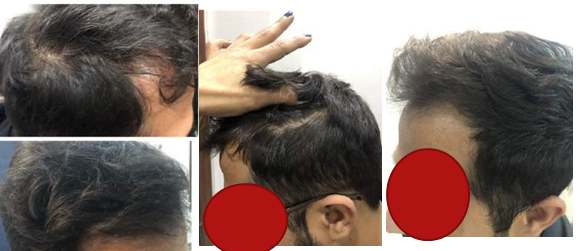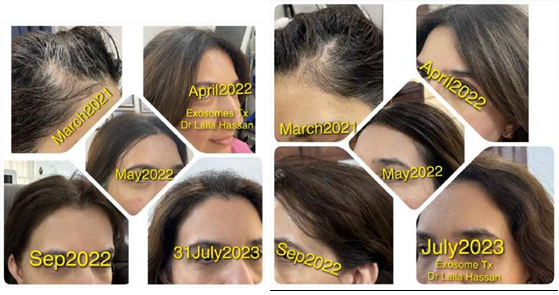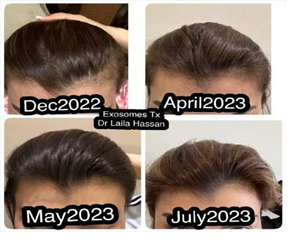Past Issues
Compare the Efficacy of PRP Intervention VS Exosomes for Hair loss, a Case Series Study
Laila Hassan1,*, Kashif Ali Samin2, Samina Mohsin3, Muhammad Iqbal Asif4, Neeta Maheshwary5, Arjumand Ahmed6
1Aesthetic Physician; Diplomate and Board Certified by the American Board of Laser Surgery (ABLS); Diploma in Hospital Management from National University of Science and Technology (NUST); Director of Business and Development for Pakistan, American Board of Laser Surgery (ABLS) ;Visiting Faculty, Khyber Medical University, Peshawar, Pakistan; Visiting Faculty, Health Services Academy; Member of Association of Aesthetic Physicians of Pakistan (AAPP)
2Department of Aesthetic Medicine, Khyber medical University, Peshawer Pakistan, Associate Professor, Pakistan
3Aesthetic Physician, Diplomate, American Academy of Aesthetic Medicine (USA), Postgraduate Diploma in Clinical Dermatology (Cardiff, Wales (UK), Master’s in Public Health (Quaid e Azam University, Islamabad, Pakistan), Associate Professor, Health Services Academy, Islamabad, Pakistan, President, Association of Aesthetic Physicians of Pakistan, Visiting Faculty, Khyber Medical University, Peshawar, Pakistan, Visiting Faculty, Riphah International University, Islamabad, Pakistan
4MBBS, Karachi Medical & Dental College, Karachi, Pakistan
5MBBS, Ziauddin University, Karachi, Pakistan; Head of Medical Affairs Department Helix Pharma Pvt. Ltd., Karachi, Pakistan
6Pharm-D, Dow University of Health Sciences, Karachi, Pakistan; Medical Affairs Department Helix Pharma Pvt. Ltd., Karachi, Pakistan
*Corresponding Author: Laila Hassan, Visiting Faculty Health Services Academy, Dip Hospital management NUST, Pakistan; Email: [email protected]; [email protected]
Received Date: March 21, 2024
Publication Date: April 23, 2024
Citation: Hassan L, et al. (2024). Compare the Efficacy of PRP Intervention VS Exosomes for Hair loss, a Case Series Study. Dermis. 4(3):19.
Copyright: Hassan L, et al. © (2024).
ABSTRACT
Background: Hair loss, a prevalent concern affecting a diverse demographic, has prompted the exploration of regenerative therapies such as Platelet-Rich Plasma (PRP) and Exosomes. While both interventions show promise in hair restoration, limited comparative studies exist, necessitating a comprehensive investigation. Objective: This case series study aims to compare the efficacy of Platelet-Rich Plasma (PRP) intervention and Exosomes as regenerative therapies for the treatment of hair loss. PRP and Exosomes have gained attention as promising interventions in hair restoration but limited comparative studies exist. Material and methods: The study has enrolled total 5 participants experiencing hair loss. The participants were divided into two groups: Group A, 3 patients received PRP intervention, and Group B, 2 patients received Exosomes therapy. The PRP group (average age 29, all male) underwent 5-6 sessions over 6-16 months, while the Exosomes group (average age 43, all female) received one session with observation periods ranging from 7 to 28 months. Result: Both treatments demonstrated positive outcomes in improving or maintaining condition scores. PRP showed varying improvements, while Exosomes exhibited significant improvement after a single session, outperforming PRP. Conclusion: The study suggests the need for further research with larger sample sizes and longer-term follow-ups for a comprehensive evaluation of treatment efficacy.
Keywords: Hair loss; Platelet-Rich Plasma (PRP); Exosomes; Regenerative therapies
INTRODUCTION
Hair loss, a prevalent concern affecting a diverse demographic, has prompted the exploration of regenerative therapies such as Platelet-Rich Plasma (PRP) and Exosomes. While both interventions show promise in hair restoration, limited comparative studies exist, necessitating a comprehensive investigation. PRP, derived from the patient's blood, has emerged as a therapeutic option for various forms of hair loss, including androgenetic alopecia and female pattern hair loss. Its versatility allows for independent use or in conjunction with conventional treatments. Notably, PRP has shown positive effects in conditions like alopecia areata, serving as a steroid-sparing alternative. However, standardization of PRP treatment protocols remains an imperative research focus.
On the other hand, Exosomes, extracellular vesicles vital in cell communication and organogenesis, have gained attention for their role in hair morphogenesis and regeneration. As a relatively novel approach, Exosomes present a promising avenue for treating alopecia, addressing the challenges posed by traditional methods. The current landscape of regenerative aesthetics, encompassing skin rejuvenation and hair restoration, further underscores the potential of Exosomes in overcoming hair loss. With the growing interest in these regenerative therapies, this case series study aims to provide valuable insights into the comparative efficacy of PRP and Exosomes for hair loss treatment, drawing attention to their clinical outcomes and potential implications for future therapeutic strategies.
Platelet Rich Plasma
PRP emerges as a promising therapeutic alternative for various forms of hair loss, encompassing androgenetic alopecia and female pattern hair loss. It can be employed either independently or in conjunction with conventional treatments or hair transplantation. In the case of alopecia areata, PRP is regarded as a secure and effective option, serving as a steroid-sparing alternative. Additionally, there is evidence suggesting that PRP may ameliorate clinical symptoms in certain types of cicatricial alopecia. Nevertheless, further research is imperative to establish the standard procedures for PRP treatment, encompassing preparation, regimen, dosing protocols, injection techniques, and the optimal number and intervals of treatment sessions to maximize therapeutic efficacy [1]. Another study shows that the interfollicular injection of autologous CD34+ cell-containing PRP preparation has a positive therapeutic effect on male and female pattern hair loss without remarkable major side-effects [2].
Platelet-rich plasma (PRP) has emerged as a novel approach in regenerative plastic surgery, showing promise in promoting hair regrowth. This study presents findings from a randomized, placebo-controlled, half-head group investigation comparing hair regrowth between PRP and a placebo. Quantification, conducted by a blinded evaluator using computerized trichograms, revealed clinical improvement in the mean number of hairs. Among the 23 enrolled patients, excluding 3, the results after three treatment cycles demonstrated a notable mean increase of 33.6 hairs in the target area and a total hair density increase of 45.9 hairs per cm2 compared to baseline values. Importantly, no side effects were observed during the treatment, underscoring the positive impact of PRP injections on male pattern hair loss and the absence of significant adverse effects [3].
Exosomes Treatment
Alopecia, a frequently encountered concern, poses challenges in terms of effective treatment. Consequently, there is a growing focus on regenerative therapies aimed at stimulating hair growth. Exosomes, extracellular vesicles pivotal in cell communication, homeostasis, differentiation, and organogenesis, have demonstrated a key role in hair morphogenesis and regeneration. This positions them as promising candidates for the treatment of alopecia [4]. According to the published review, this is to shed light on the present and evolving role of exosomes in aesthetic medicine, encompassing areas such as skin rejuvenation and hair restoration [5].
METHODS
A case series, retrospective and observational study has enrolled total 5 participants experiencing hair losses were enrolled in this study. The participants were divided into two groups: Group A, 3 patients received PRP intervention, and Group B, 2 patients received Exosomes therapy. The study employed a rigorous methodology, including standardized protocols for preparation and administration of PRP and Exosomes. Various parameters, including hair regrowth, hair density, and patient satisfaction, were assessed at variable intervals throughout the study period.
Table 1: PRP Treatment.
|
PRP Treatment |
|
|
Patient 1 (Age 36, Male) |
After complete treatment of 6 sessions in 6 months of hair loss patients, we have observed score of total 8. Whenever initial score was 5 out of 10. This indicates a successful outcome. |
|
Patient 2 (Age 29, Male) |
Five sessions of PRP over 16 months resulted in a high score of 9. Despite longer treatment duration in PRP treatment group, the patient achieved a favorable outcome, suggesting sustained improvement. |
|
Patient 3 (Age 22, Male) |
Six sessions of PRP over six months resulted in a score of 8 out 10, when initial score before treatment was 4. This indicates a positive response. |
Table 2: Exosomes Treatment Exosomes Treatment.
|
Exosomes Treatment Exosomes Treatment |
|
|
Patient 1 (Age 40, Female) |
1 session and follow-up observations over 28 months resulted in the score of 8 out of 10. This patient demonstrated a positive response with a single treatment during multiple follow up visits. |
|
Patient 1 (Age 46, Female) |
Single session and following observation over 7 months resulted in a score of 8 out of 10, as initial score was 4. The result of the single treatment during 7 month, got the score 8 suggests a maximum improvement in minimum duration of follow-up |
PRP Treatment:
- After complete treatment of 6 sessions in 6 months of hair loss patients, we have observed score of total 8. Whenever initial score was 5 out of 10. This indicates a successful outcome.
2.Patient 2 (Age 29, Male)
-
Five sessions of PRP over 16 months resulted in a high score of 9. Despite longer treatment duration in PRP treatment group, the patient achieved a favorable outcome, suggesting sustained improvement.
3.Patient 3 (Age 22, Male):
-
Six sessions of PRP over six months resulted in a score of 8 out 10, when initial score before treatment was 4. This indicates a positive response.
Exosomes Treatment
1.Patient 1 (Age 40, Female):
-
1 session and follow-up observations over 28 months resulted in the score of 8 out of 10. This patient demonstrated a positive response with a single treatment during multiple follow up visits.
2.Patient 1 (Age 46, Female):
-
Single session and following observation over 7 months resulted in a score of 8 out of 10, as initial score was 4. The result of the single treatment during 7 months, got the score 8 suggests a maximum improvement in minimum duration of follow-up.
RESULTS
COMPARISON
1. Patient Demographics and Treatment Parameters:
• PRP Group: Average age 29, all male patients. Number of sessions ranged from 5 to 6, with treatment durations ranging from 6 to 16 months.
• Exosomes Group: Average age 43, all female patients. Patients received 1 session each with a duration of observation ranging from 7 to 28 months.
2. Condition Score Improvement (1 to 10):
• PRP Group: Patients experienced improvements in condition scores ranging from 1 to 4 points.
• Exosomes Group: Patients maintained their condition scores, with consistent good result.
3. Session Duration and Frequency:
• PRP Group had a consistent number of sessions (5 to 6) with varying treatment durations.
• Exosomes Group received only 1 session each, and the duration of observation varied.
4. Overall Observations:
• Both PRP and Exosomes treatments demonstrated positive outcomes in improving or maintaining the condition scores for hair loss.
• PRP treatment showed varying degrees of improvement in condition scores, with a maximum improvement of 4 points.
• Exosomes treatment showed significant improvement in single treatment as compare with PRP multiple treatments.
• Exosomes treatment outperforms PRP treatment, yielding results with just a single treatment session.
5. Consideration for Further Study:
• The study highlights differences in treatment parameters and outcomes, suggesting the need for additional investigation.
• Larger sample sizes and more extensive studies are recommended for a comprehensive understanding of the comparative efficacy and durability of these treatments.
DISCUSSION
The comparative analysis of Platelet-Rich Plasma (PRP) and Exosomes as regenerative therapies for hair loss reveals intriguing insights. Patient demographics and treatment parameters vary significantly between the two groups, with PRP administered to an all-male group aged 29 on average, undergoing 5 to 6 sessions over 6 to 16 months, while Exosomes treatment was given to all females in a single session, with observation periods ranging from 7 to 28 months. The distinct differences underscore the heterogeneity in regenerative approaches and prompt considerations regarding treatment practicality and patient preferences.
Condition score improvements, a key measure of treatment efficacy, demonstrate positive outcomes for both interventions. PRP recipients experienced varying degrees of improvement in condition scores, ranging from 1 to 4 points. In contrast, Exosomes recipients maintained consistent good results, suggesting stability after a single session. This divergence in the pattern of improvement indicates potential variations in the mechanisms and long-term effects of these regenerative therapies.
The discussion also highlights the session duration and frequency, with PRP recipients consistently undergoing 5 to 6 sessions, while Exosomes recipients received only one session. The study underscores the efficacy of Exosomes, showcasing significant improvement in hair loss with minimal intervention. The absence of observed side effects in either group reaffirms the safety profile of these regenerative treatments.
Despite the positive outcomes, the study concludes with a call for further investigation. The differences in treatment parameters and outcomes emphasize the necessity for larger sample sizes and more extensive studies to comprehensively evaluate the comparative efficacy and durability of PRP and Exosomes treatments. This recognition of the study's limitations points towards the dynamic nature of regenerative therapies for hair loss, urging continued research for optimized treatment protocols.
CONCLUSION
Both PRP and Exosomes treatments exhibited favorable results; PRP led to improvements in condition scores, while Exosomes maintained stability after a single treatment session. Notably, PRP involved multiple treatment sessions. The variations in treatment parameters, along with the limited sample size, underscore the necessity for additional research to discern the most effective approach to hair loss treatment, considering individual patient characteristics and preferences. Furthermore, conducting longer-term follow-ups and implementing larger-scale studies is crucial for a more comprehensive evaluation of treatment efficacy.
REFERENCES
- Paichitrojjana A, Paichitrojjana A. (2022). Platelet Rich Plasma and Its Use in Hair Regrowth: A Review. Drug Des Devel Ther. 16:635-645.
- Kang JS, Zheng Z, Choi MJ, Lee SH, Kim DY, Cho SB. (2014). The effect of CD341 cell-containing autologous platelet-rich plasma injection on pattern hair loss: a preliminary study. J Eur Acad Dermatol Venereol. 28(1):72-79.
- Gentile P, Garcovich S. (2015). The Effect of Platelet-Rich Plasma in Hair Regrowth: A Randomized Placebo-Controlled Trial. Stem Cells Transl Med. 4(11):1317-1323.
- Kost Y, Muskat A. (2022). Exosome therapy in hair regeneration: A literature review of the evidence, challenges, and future opportunities. J Cosmet Dermatol. 21(8):3226-3231.
- Vyas KS, Kaufman J. (2023). Exosomes: the latest in regenerative aesthetics. Regen Med. 18(2):181-194.
- Metwalli M, Khattab FM. (2021). Monofilament threads in the treatment of female hair loss. J Dermatolog Treat. 32(5):521-525.
- Gkini MA, Kouskoukis AE, Tripsianis G, Rigopoulos D, Kouskoukis K. (2014). Study of platelet-rich plasma injections in the treatment of androgenetic alopecia through a one-year period. J Cutan Aesthet Surg. 7:213-219.
- Li ZJ, Choi HI, Choi DK, Sohn KC, Im M, Seo YJ, et al. (2012). Autologous platelet-rich plasma: A potential therapeutic tool for promoting hair growth. Dermatol Surg. 38:1040–1046.
- Khatu SS, More YE, Gokhale NR, Chavhan DC, Bendsure N. (2014). Platelet-rich plasma in androgenic alopecia: myth or an effective tool. J Cutan Aesthet Surg. 7:107-110.
- Trink A, Sorbellini E, Bezzola P, Rodella L, Rezzani R, Ramot Y, et al. (2013). A randomized, double-blind, placebo- and active-controlled, half-head study to evaluate the effects of platelet-rich plasma on alopecia areata. Br J Dermatol. 169:690–694.
- Sperling LC. (2018). Alopecias. In: Dermatology. 4th ed. Elsevier:1162-1187.
- Yuan AR, Bian Q, Gao JQ. (2020). Current advances in stem cell-based therapies for hair regeneration. Eur J Pharmacol. 881:173197.
- Stevens J, Khetarpal S. (2019). Platelet-rich plasma for androgenetic alopecia: A review of the literature and proposed treatment protocol. Int J Womens Dermatol. 5(1):46-51.
- Kalluri R, LeBleu VS. (2020). The biology, function, and biomedical applications of exosomes. Science. 367(6478):1-15.
 Abstract
Abstract  PDF
PDF



